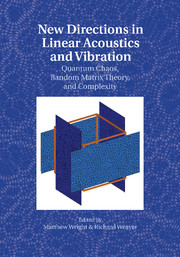Book contents
- Frontmatter
- Contents
- Foreword by Michael Berry
- Introduction
- 1 The Semiclassical Trace Formula
- 2 Wave Chaos for the Helmholtz Equation
- 3 The Unreasonable Effectiveness of Random Matrix Theory for the Vibrations and Acoustics of Complex Structures
- 4 Gaussian Random Wavefields and the Ergodic Mode Hypothesis
- 5 Short Periodic Orbit Theory of Eigenfunctions
- 6 Chaotic Wave Scattering
- 7 Transfer Operators Applied to Elastic Plate Vibrations
- 8 Mesoscopics in Acoustics
- 9 Diagrammatic Methods in Multiple Scattering
- 10 Time-Reversed Waves in Complex Media
- 11 Ocean Acoustics: A Novel Laboratory for Wave Chaos
- 12 Mesoscopic Seismic Waves
- 13 Random Matrices in Structural Acoustics
- 14 The Analysis of Random Built-Up Engineering Systems
- References
- Index
3 - The Unreasonable Effectiveness of Random Matrix Theory for the Vibrations and Acoustics of Complex Structures
Published online by Cambridge University Press: 05 October 2010
- Frontmatter
- Contents
- Foreword by Michael Berry
- Introduction
- 1 The Semiclassical Trace Formula
- 2 Wave Chaos for the Helmholtz Equation
- 3 The Unreasonable Effectiveness of Random Matrix Theory for the Vibrations and Acoustics of Complex Structures
- 4 Gaussian Random Wavefields and the Ergodic Mode Hypothesis
- 5 Short Periodic Orbit Theory of Eigenfunctions
- 6 Chaotic Wave Scattering
- 7 Transfer Operators Applied to Elastic Plate Vibrations
- 8 Mesoscopics in Acoustics
- 9 Diagrammatic Methods in Multiple Scattering
- 10 Time-Reversed Waves in Complex Media
- 11 Ocean Acoustics: A Novel Laboratory for Wave Chaos
- 12 Mesoscopic Seismic Waves
- 13 Random Matrices in Structural Acoustics
- 14 The Analysis of Random Built-Up Engineering Systems
- References
- Index
Summary
Introduction
The applicability of random matrix theory (RMT) to acoustic systems has been demonstrated in recent years by a number of acoustical researchers, e.g., Weaver, Ellegaard, Langley, and Soize. Nevertheless, the field remains obscure to acousticians, and newcomers often find themselves perplexed. Why ought we believe this contention that a simple ensemble of random matrices describes an ensemble of structural or acoustic systems? Or more pointedly, why ought a single sample from such an ensemble represent one such system? What are the chief predictions of RMT; of what utility are they, and of what generality? The contention is, at first thought, absurd. And yet there is much empirical evidence of the relevance of RMT. There are furthermore several examples of its utility and correctness; it makes useful and accurate predictions.
There has been much attention paid in the acoustics community to uncertain systems. Although the broad features of an elastic or acoustic structure may be described with some confidence, details can vary, owing to randomness in manufacturing or to accumulated wear, or merely to irregularities that exceed the ability or patience of a numerical model. Such observations are widely invoked to justify the applicability of statistics. Random matrices represent a limit of uncertain systems. It is perhaps unsurprising that in the limit of maximum uncertainty, universal (i.e., pertaining to a class of systems) nontrivial statistics may be derived. These include statistics for the eigenfrequencies and eigenfunctions and for the responses.
Information
- Type
- Chapter
- Information
- New Directions in Linear Acoustics and VibrationQuantum Chaos, Random Matrix Theory and Complexity, pp. 42 - 58Publisher: Cambridge University PressPrint publication year: 2010
Accessibility standard: Unknown
- 1
- Cited by
